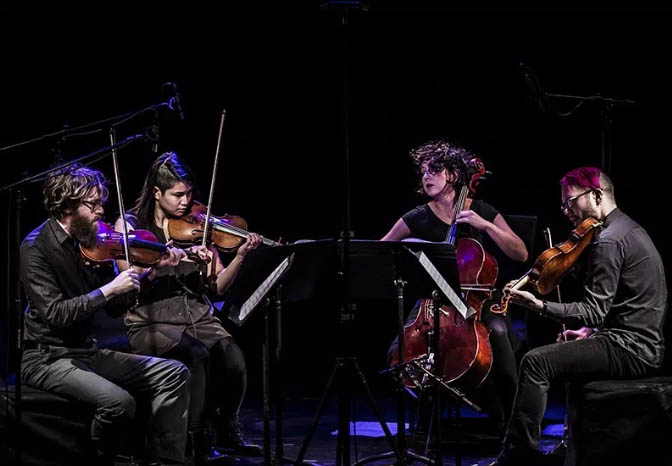The American Contemporary Music Ensemble, better known by its acronym, ACME, came to Portland on Thursday evening to offer a varied, if remarkably concise, overview of modernist styles, ranging from Morton Feldman’s 1960’s experiments in textural sparseness and Charlemagne Palestine’s 1974 essay in gradually expanding Minimalist repetition, to Philip Glass’s post-Minimal neo-Classicism and a tape-loop-driven sound picture by Clarice Jensen, the ensemble’s artistic director and cellist.
The concert, which was presented by Portland Ovations, was also a collaboration with the Institute of Contemporary Art at the Maine College of Art, and took place in the school’s Lunder Gallery, amid the artworks in the institute’s “Drawing Now.”
There is a long tradition of staging contemporary music in galleries, where artists’ and composers’ sensibilities often dovetail affectingly. In Portland, for example, new-music concerts are more typically presented at Space, just a few doors from MECA. It’s good to see the school getting into the contemporary concert business as well, and in this case, the exhibition’s works, many of them black and white, and starkly geometrical, suited the music perfectly.
Jensen opened the program on her own, with the second (and longer) movement of “For This From That Will Be Filled,” the title work of her 2018 solo recording. The work’s backdrop is an electronic score, built of drones, looped sounds, ambient recording made at Grand Central Station in New York and other sounds that are difficult to distinguish but create a solid, sometimes aggressive fabric.
Against all that, Jensen’s solo lines alternately weave through the din and soar over it, but if you’re looking at the cello line as the sole source of musical development, you’re looking in the wrong place: Much of the action actually happens in the dense electronic score, where subtle shifts of color and weight periodically give way to more sudden and striking change. The cello line, by contrast, seems almost a quaint throwback to an earlier era, asserting itself, not always successfully, within the high-tech texture.
Glass’s String Quartet No. 5 (1991) seemed tamely conventional by comparison, and in a way, it is: Glass, by this point, had abandoned the “additive process” approach that defined his early work – a style in which musical lines were repeated many times, yet subtly altered by the addition of notes or phrases after a certain number of repetitions. That process, fresh and effective in its day, saddled Glass with a reputation as a composer who did nothing but repeat himself.
Even in the early days that was not quite accurate, but by the time of the Quartet No. 5, repetition was hardly his signature move. That’s not to say that there isn’t any, but phrases may be repeated two or three times before giving way to something entirely different, rather than 40 or 50 times before being gradually altered. Here, he begins with a sweetly harmonized theme with an almost Gallic accent, and makes his way quite far afield, over 23 minutes, touching on blues figures, shimmering fast textures, a brief (and startling) pizzicato episode and even an allusion to the ascending and descending “rocket” figures heard in “Einstein on the Beach.”
Feldman is sometimes thought of as a proto-Minimalist, not because he used repetition (he didn’t, and Minimalism was always about more than that), but because he tended to reduce his musical materials to the bare essentials – quiet, sustained pitches, silences, gentle dissonances – explored over long stretches of time, sometimes as much as five hours.
Feldman’s “Durations II” (1960), for piano, violin and cello, and the pointillistic “Durations IV” (1961), with a vibraphone replacing the piano, are outliers in that they each run less than five minutes. But all the other elements are intact in these graceful, alluring works, which exert a hypnotic effect and all but demand that the listener examine each tone and combination of timbres from multiple perspectives.
As its finale, ACME played Jensen’s arrangement of Charlemagne Palestine’s “Strumming Music” (1974), a work in which repetition is a motivating force, with a generally (but not absolutely) steady rhythm heard throughout, almost as a pulse. It was the only work performed by the full ensemble – violinists Ben Russell and Ravenna Lipchik, violist Caleb Burhans, pianist Peter Dugan, Jensen on cello and Chihiro Shibayama on vibraphone – and it involved constantly recalibrated, consistently attractive textures.
There is no such thing as a definitive performance of a work like “Strumming Music.” Palestine was liberal about tempos, durations and even scoring (the piece was originally for piano, and he created a version for strings). His own recording runs about 54 minutes. ACME’s version was about half that length.
Allan Kozinn is a former music critic and culture writer for The New York Times who lives in Portland. He can be contacted at:
allankozinn@gmail.com
Twitter: kozinn
Send questions/comments to the editors.



Success. Please wait for the page to reload. If the page does not reload within 5 seconds, please refresh the page.
Enter your email and password to access comments.
Hi, to comment on stories you must . This profile is in addition to your subscription and website login.
Already have a commenting profile? .
Invalid username/password.
Please check your email to confirm and complete your registration.
Only subscribers are eligible to post comments. Please subscribe or login first for digital access. Here’s why.
Use the form below to reset your password. When you've submitted your account email, we will send an email with a reset code.